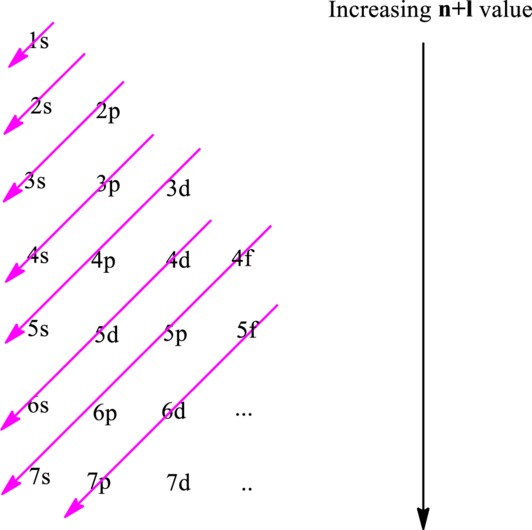
(a)
Interpretation:
Number of valence electrons in
Concept Introduction:
The fundamental principles that are followed to write an electronic configuration include three rules as follows:
Electron in a

Hund’s rule suggests electrons are not allowed to be paired up until each degenerate set of orbital has got at least one electron.
Pauli Exclusion Principle states two electrons within the same orbital cannot possess same set for four possible quantum numbers.
In
(b)
Interpretation:
Number of valence electrons in
Concept Introduction:
Refer to part (a).
(c)
Interpretation:
Number of valence electrons in
Concept Introduction:
Refer to part (a).
(d)
Interpretation:
Number of valence electrons in
Concept Introduction:
Refer to part (a).
Want to see the full answer?
Check out a sample textbook solution
Chapter 2 Solutions
Chemical Principles: The Quest for Insight
- The first three ionization energies of an element X are 900, 1745, and 14912 kJ·mol–1. What is the most likely formula for the stable ion of X?arrow_forwardWhich of the following atoms and ions is largest: S2 - , S, O2 - ?arrow_forwardWhat has the highest number valence electrons: N, Ca, O, As, or I?arrow_forward
- How are measurements of paramagnetism used to support electron configurations derived spectroscopically? Use Cu(I) and Cu(II) chlorides as examples.arrow_forwardConsider the Mg2+, Cl-, K+, and Se2- ions. The four spheresbelow represent these four ions, scaled according to ionic size.(a) Without referring to Figure 7.8, match each ion to its appropriatesphere. (b) In terms of size, between which of the sphereswould you find the (i) Ca2 + and (ii) S2 - ions? [Section 7.3]arrow_forwardWrite the electron configuration for Si7+ ion.arrow_forward
- Based on their positions in the periodic table, list the following ions in order of increasing radius: K+, Ca2+, Al3+, Si4+.arrow_forwardSince the first ionization energy of rubidium is +403 kJ mol, how many kJ of energy is it required to convert 22.90 g gaseous rubidium to +1 monoatomic ion at constant temperature?arrow_forwardAt first glance, we expect the Zeff of a valence electron of sodium (Z = 11) to be 1 but in reality, it is closer to 2.667 because _____.arrow_forward
- Which group in the periodic table has elements with high (en-dothermic) IE₁ and very negative (exothermic) first electronaffinities (EA₁)? Give the charge on the ions these atoms formarrow_forwardIf the molecule XY, which has an enthalpy of ionization of 1,500 kJ/mol as per the reaction below, can be ionized: HY + hν à HY+ + e- How much energy would be required and to which kind of light this energy correspond. Should we be concerned about this reaction happening 100 ft from the surface of the earth? Explain why or why not..arrow_forwardUse the electron affinity (EA) data for ClCl , BrBr , and II , along with your knowledge of periodic trends, to estimate the electron affinity of astatine to two significant figures.arrow_forward
 Introductory Chemistry: A FoundationChemistryISBN:9781337399425Author:Steven S. Zumdahl, Donald J. DeCostePublisher:Cengage Learning
Introductory Chemistry: A FoundationChemistryISBN:9781337399425Author:Steven S. Zumdahl, Donald J. DeCostePublisher:Cengage Learning Chemistry for Engineering StudentsChemistryISBN:9781337398909Author:Lawrence S. Brown, Tom HolmePublisher:Cengage Learning
Chemistry for Engineering StudentsChemistryISBN:9781337398909Author:Lawrence S. Brown, Tom HolmePublisher:Cengage Learning General Chemistry - Standalone book (MindTap Cour...ChemistryISBN:9781305580343Author:Steven D. Gammon, Ebbing, Darrell Ebbing, Steven D., Darrell; Gammon, Darrell Ebbing; Steven D. Gammon, Darrell D.; Gammon, Ebbing; Steven D. Gammon; DarrellPublisher:Cengage Learning
General Chemistry - Standalone book (MindTap Cour...ChemistryISBN:9781305580343Author:Steven D. Gammon, Ebbing, Darrell Ebbing, Steven D., Darrell; Gammon, Darrell Ebbing; Steven D. Gammon, Darrell D.; Gammon, Ebbing; Steven D. Gammon; DarrellPublisher:Cengage Learning Chemistry: Principles and ReactionsChemistryISBN:9781305079373Author:William L. Masterton, Cecile N. HurleyPublisher:Cengage Learning
Chemistry: Principles and ReactionsChemistryISBN:9781305079373Author:William L. Masterton, Cecile N. HurleyPublisher:Cengage Learning Chemistry: The Molecular ScienceChemistryISBN:9781285199047Author:John W. Moore, Conrad L. StanitskiPublisher:Cengage Learning
Chemistry: The Molecular ScienceChemistryISBN:9781285199047Author:John W. Moore, Conrad L. StanitskiPublisher:Cengage Learning Principles of Modern ChemistryChemistryISBN:9781305079113Author:David W. Oxtoby, H. Pat Gillis, Laurie J. ButlerPublisher:Cengage Learning
Principles of Modern ChemistryChemistryISBN:9781305079113Author:David W. Oxtoby, H. Pat Gillis, Laurie J. ButlerPublisher:Cengage Learning





